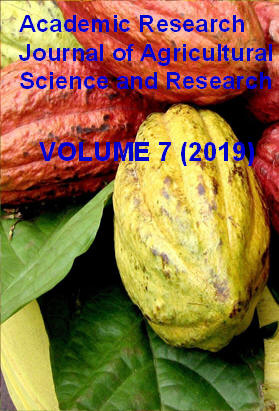|
ISSN: 2360-7874 |
Academic Research Journal of
Agricultural Science and Research |
|||||||||||||||||||
|
Vol. 7(5), pp. 266-288, July 2019 Research GGE Biplot for Grain Yield and, Estimation of Variance Components and Heritability of Agronomic Traits for Early Maturing Sorghum (Sorghum bicolor L. Moench) Genotypes
Chalachew Endalamaw*, Taye Tadesse, Amare Seyoum, Adane G/yohannes and Amare Nega
Ethiopian Institute of Agricultural Research (EIAR), Melkassa Agriculture Research Center, P. O. Box 436, Adama, Ethiopia. * Corresponding author: Chalachew Endalamaw, Ethiopian Institute of Agricultural Research (EIAR), Melkassa Agriculture Research Center, P. O. Box 436, Adama, Ethiopia; E-mail: chalachew23@gmail.com
Accepted 31 July 2019
Genotypes are grown in trials across multiple locations and years,
known as multi-environment trials (METs). Genetic performance across
these locations is measured as genotype by environment interaction (GEI).
Combined analyses of variance showed significant differences for
genotypes, environments and genotype by environment (GE). The genotypes
G54, G76, G52 and G41 were early flowering and high yielding, and
possessed other desirable agronomic traits. The highest heritability was
recorded for plant height (PHT), days to 50% flowering (DTF) and grain
yield (GY). Among the test locations the most discriminating and
representative locations were Sheraro and Meisso stations, respectively.
The vertex genotypes in this investigation were G74, G28, G64, G19, G16,
G22, G5, G30 and G76. G74 is the winning genotype for the
mega-environment which consists of Humara in 2015 (15HM), Meisso in 2015
(15MI) and Sheraro in 2016 (16SH), while G14 is the winning genotype for
Erer in 2116 (16ER) and Meisso in 2016(16MI) mega-environment and G30
winning genotype for the 15SH mega-environment. Genotypes G41, G54 and
G76 are stable and high yielding than the commercial sorghum varieties,
G90 (Melkam) and G87 (Dekeba); hence, can be selected as the most
favorable genotypes. Thus, based on the graphical interpretation,
genotypes G54 and G76 followed by G25, G41 and G74 with high mean yield
and stability performances can be considered as ideal genotypes. The G76
had higher than average yield in all environments, whilst it had the
highest yield in Sheraro. It was concluded that genotype G76 showed the
best stable performance in all locations, suggesting that it is a
promising breeding material in future breeding programs of sorghum in
Ethiopia. The results obtained through the study provide valuable
information on understanding GxE interaction, genotypic variation in
response to different diverse environments and application of GGE biplot
to analyze GxE interaction to sorghum breeding in Ethiopia. The
development of varieties with broad adaptation is strongly supported,
rather than location-specific varieties. How to cite this article (APA Style): Chalachew E., Taye T., Amare S., Adane G., Amare N (2019). GGE Biplot for Grain Yield and, Estimation of Variance Components and Heritability of Agronomic Traits for Early Maturing Sorghum (Sorghum bicolor L. Moench) Genotypes. Acad. Res. J. Agri. Sci. Res. 7(4): 266-288
|
|||||||||||||||||||
